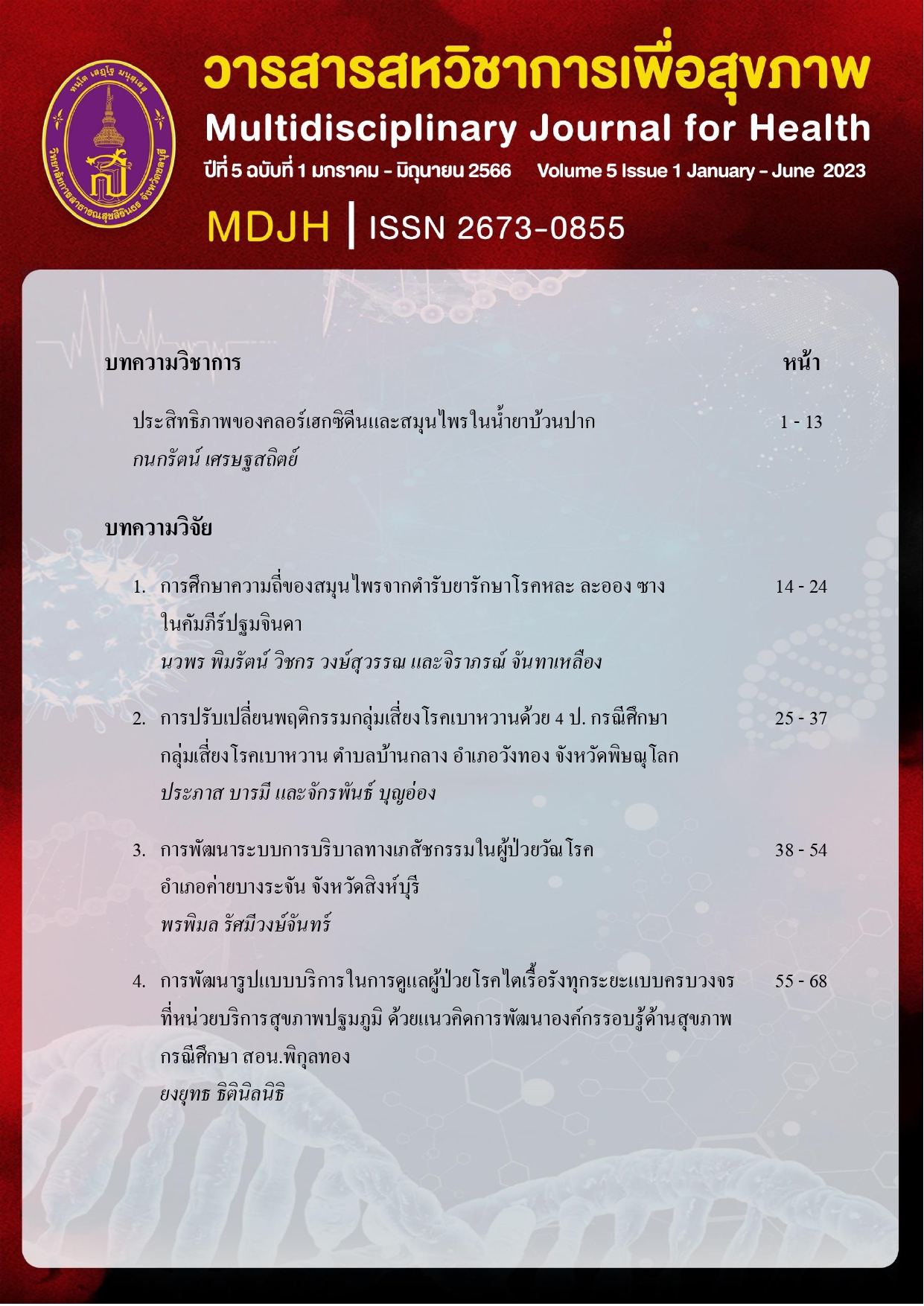ประสิทธิภาพของคลอร์เฮกซิดีนและสมุนไพรในน้ำยาบ้วนปาก
คำสำคัญ:
น้ำยาบ้วนปาก, คลอร์เฮกซิดีน, สมุนไพร, แผ่นคราบจุลินทรีย์บทคัดย่อ
น้ำยาบ้วนปากเป็นหนึ่งในผลิตภัณฑ์การดูแลสุขภาพช่องปากและฟันที่คนส่วนใหญ่เลือกใช้เพื่อการลดกลิ่นปาก ระงับการเจริญเติบโตของเชื้อแบคทีเรีย ลดการเกิดแผ่นคราบจุลินทรีย์ น้ำยาบ้วนปากมีลักษณะเป็นของเหลวอาจจะมีสีหรือไม่มีสี ประกอบไปด้วยสารพื้นฐานหลายชนิด สารออกฤทธิ์เป็นส่วนประกอบของน้ำยาบ้วนปากที่ตอบสนองวัตถุประสงค์ของการใช้น้ำยาบ้วนปาก สารออกฤทธิ์จะมีทั้งชนิดที่เป็นสารเคมี เช่น คลอร์เฮกซิดีน หรือสมุนไพร เช่น ชาเขียว แต่อย่างไรก็ตาม คลอร์เฮกซิดีนและสมุนไพรอาจทำให้เกิดผลข้างเคียงได้ ผลข้างเคียงของคลอร์เฮกซิดีน ได้แก่ การเกิดคราบสีบนตัวฟันการบวมของต่อมน้าลายพาโรติด อาการเจ็บบริเวณเยื่อเมือกช่องปาก เป็นต้น ในทำนองเดียวกันน้ำยาบ้วนปากสมุนไพรก็สามารถก่อให้เกิดอาการข้างเคียงได้เช่นเดียวกัน ได้แก่ ทำให้การรับรสน้อยลง ทำให้เกิดอาการวิงเวียนศีรษะ ทำให้เกิดคราบสีบนตัวฟัน โดยการเกิดคราบสีบนตัวฟันจะเกิดน้อยกว่าน้ำยาบ้วนปากคลอร์เฮกซิดีน และน้ำยาบ้วนปากสมุนไพรบางชนิดไม่ก่อให้เกิดคราบสีบนตัวฟัน
เอกสารอ้างอิง
Joiner A. The Cleaning of Teeth. Handbook for cleaning/decontamination of surfaces. (2007).
สุจินมนต์ พรหมประดิษฐ์. ยาสีฟันและน้ำยาบ้วนปากเป็นตัวช่วยป้องกันโรคเหงือกได้จริงหรือไม่. วิทยาสารทันตสาธารณสุข. 2556; 18(1) : 9-18.
American Dental Association. Mouthrinse (Mouthwash). Department of Scientific Information, ADA Science Institute. Accessed on 1 December 2021.
กิตติโชติ วรโชติกำจร. น้ำยาบ้วนปาก. (บทความวิชาการ) ศูนย์การศึกษาต่อเนื่องทางเภสัชศาสตร์. คณะเภสัชศาสตร์ มหาวิทยาลัยสงขลานครินทร์; 2562.
Balsam MS, Sagarin MM. Cosmetic and Technology 1972; 3(1). Wiley-interscience, New York.
Löe H, Schiøtt CR. The effect of mouthrinses and topical application of chlorhexidine on the development of dental plaque and gingivitis in mas. J Preiodontal Res 1970; 5(2).
Rölla G, Melsen B. On the mechanism of the plaque inhibition by chlohexidine. J Dent Res 1975; 54: 57-62.
Gjermo P, Bonesvoll P, Rölla G. Relationship between plaque-innibiting effect and retention of chlorhexidine in the human oral cavity. Arch Oral 1974; 19(11).
Bonesvoll P, Lökken P, Rölla G, Paus PN. Retention of chlorhexidine in the human oral cavity after mouth rines. Arch Oral Biol 1974; 19(3).
Quirynen M, Avontroodt P, Peeters W, Pauwels M, Coucke W, Van Steenberghe D. Effect of different chlorhexidine formulations in mouthrinse on de novo plaque formation. J Clin Periodontol 2001; 28(12): 1127-36.
Cheung HY, Wong MMK, Cheung SH, Liang LY, Lam YW, Chiu SK. Differential actions of chlorhexidine on the cell wall of bacillus subtilis and Escherichia coli. PLoSOne 2012; 7(5): e36659.
James P, Worthington H., Parnell C, Harding M, Lamont T, Cheung A. Chlorhexidine mouthrinse as an adjunctive treatment for gingival health Cochrane Database Syst Rev 2017; 3(3): CD0008676.
Kampf G, Todt D, Pfaender S, Steinmann E. Pesistence of coronaviruses on inanimate surface and their inactivation with biocidal agents. J Hosp Infect 2020; 104(3).
Yoon JG, Yoon J, Song JY, Yoon SY, Lim CS, Seong H. Clinical significance of a highSAR-Cov-2 viral load in the saliva. J Korean Med Sci 2020; 35(20): e125.
Chin AWH, Chu JTS, Perera MRA, Hui KPY, Yen HL, Chan MCW. Stability of SARA-CoV-2 in different environmental conditions. Lancet Microbe 2020;1(1): e10.
Carey MC, Yagudayev A, Fon K. Effect of Temperature on Tooth Staining by 0.12% Chlorhexidine Gluconate. Front Dent Med 2021; 2: 1-11.
Weijden GA, Ten HJM, Slot DE, Rosema NA, Van der velden U. Parotid gland swelling following mouthrinse use. Int J Dent Hyg 2010;8(4): 276-279.
Plantinga NL, Wittekamp BHJ, Leleu K, Depydt P, Van den Abeele AM, Brun-Buisson C. Oral mucosal adverse events with chlohexidine 2% mouthwash in ICU. Intensive CareMed 2016; 42(4).
Fernandes M, Lourenco T, Lopes A, Spinola SA, Pereira SMC, Pereira BM. Chlorhexidine: a hidden life-threatening allergen. Asia Pac Allergy 2019;9(4): e29.
Nagasri M, Madhulatha M, Musalaiah AVVS, Kumar PA, Krishna CHM, Kumar PM. Efficacy of curcumin as as adjunct to scaling and root planning in chronic periodontitis patients: Aclinical and microbiological study. Journal of Pharmacy &Bioallied Sciences 2015; 7; S554-S558.
Sarin S, Marya C, Nagpal R, Oberoi SS, Rekhi A. Preliminary Clinical Evidence of the Antiplaque, Antigingivitis Efficacy of a Mouthwash Containing 2% Green Tea – A Randomised Clinical Trial. Oral Health Prev Dent 2015; 13(3): 197-203.
สุวิมล ทวีชัยศุภพงษ์, โสพิศ วงศ์คำ, อาริยา รัตนทองคำ, สุภาภรณ์ สิงหรา, เทียมหทัย ชูพันธ์, สำราญ สุภาษี. ผลของการใช้น้ำยาบ้วนปากผสมสารสกัดจากใบข่อยต่อการอักเสบของเหงือกและการเกิดคราบจุลินทรีย์. วารสารทันตะ 2545; 52(6): 383-391.
วันทนี สว่างอารมณ์, พาฝัน จันทร์เล็ก. การเปรียบเทียบผลของสารสกัดจากสมุนไพรต่อการยับยั้งเชื้อแบคทีเรีย Staphylococcus aureus และ Escherichia coli. วารสารก้าวทันโลกวิทยาศาสตร์ 2555; 12(2):1-11.
Radafshar G, Ghotbizadeh M, Saadat F,Mirfarhad N. Effects of green tea (Camellia sinensis) mouthwash containing 1% tannin on dental plaque and chronic gingivitis: a double-blinded, randomized, controlled trial. J. Oral Maxillaofac Surg 2014:43:1394-1398.
Shahakbari R, Eshghpour M, Rajeal A, Rezaei NM, Golfakhrabadi P, Nejat A. Effectiveness of green tea mouthwash in comparison to chlorhexidine mouthwash in patients with acute pericoronitis: a randomized clinical trial. J. Oral Maxillofac. Surg. 2014; 43:1394-1398.
Ratika S, Mamata H, Anil V, Ankola VM, Sindhu, JS. Effect of Two Herbal Mouthwashes on Gingival Health of School Children. Journal of Traditional and Complementary Medicine 2014, 4(4): 272-278.
ธีระ ผิวเงิน, วัลลภ จันทร์สว่าง. การลดการติดคราบจุลินทรีย์ของน้ำยาบ้วนปากใบฝรั่งในผู้ป่วยเบาหวาน. วารสารเภสัชศาสตร์อีสาน 2562; 15(3): 95-103.
ดาวน์โหลด
เผยแพร่แล้ว
ฉบับ
ประเภทบทความ
สัญญาอนุญาต
ลิขสิทธิ์ (c) 2023 วารสารสหวิชาการเพื่อสุขภาพ

อนุญาตภายใต้เงื่อนไข Creative Commons Attribution-NonCommercial-NoDerivatives 4.0 International License.



